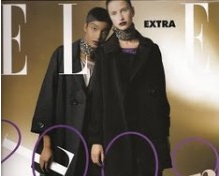
According to a 2008 survey about models in New York fashion week:
- Six percent are Black
- Six percent are Asian
- One percent are Latina
- Eighty-seven percent are White
When the modeling world is criticized, the media, activists, and the general public focus in on the fact that the standard size zero of today’s models represents a very small percentage of women in the real world. But size is not the only way the fashion industry excludes. A new short documentary, “The Colour of Beauty,” examines how the ideal in fashion is not only is rail thin, but also White. The documentary’s creator Elizabeth St. Philip, highlights Renee Thompson’s experience as a Black model in a White world:
Renee Thompson is trying to make it as a top fashion model in New York. She’s got the looks, the walk and the drive. But she’s a Black model in a world where White women represent the standard of beauty. Agencies rarely hire Black models. And when they do, they want them to look “like White girls dipped in chocolate.”
“The Colour of Beauty,” is part of the Work for All series, a Canadian project that makes “films against racism in the workplace.” View St. Philip’s documentary and learn more here.
Related content:
Censored Census: Latino Isn’t a Race
Fashion is not simply about fabrics and heel sizes; it’s about money. In a capitalist society, it is always about the money. The designers, stores, and agencies have historically targeted their fashions toward the demographic groups they believe most likely to be the most obsessed with fashion and looks and also most likely to have the means to spend copious amounts of money on getting those looks. Obviously, no corporation ever turned away a dollar when it was waved in their face, so I believe the fashion industry has done their research and absolutely does know which groups spend the most, and have tailored the racial percentages of their models to reflect that sales demographic.
In other words, the designers and designer stores want rich little white girls and rich middle-aged white wives to spend thousands of dollars on high-fashion shoes and frocks, so they throw them on models who resemble them.
Would the white girls still buy the clothes if they were on black or Latina models who do not look like them and with whom they do not self-identify? Should they want to? Should we influence them to want to, and would that carry any cost to their own self-esteem and body image? Maybe those are the questions we should be asking.
As for the percentages (taken from the documentary), yes they are shocking. How many non-white models can you come up with that don’t include Tyra Banks and Naomi Campbell? I can’t think of any.
Yes, by all means Cherry, please feel free to re-post on your blog! Thanks for spreading the word!
Sharon
I think this speaks volumes to the fact that we are *all* trying to fit into an unrealistic Eurocentric ideal of beauty. If you deviate from the Barbie or Ken standard, then you are told by the media and our culture that you need to be fixed or look white and have features dipped in chocolate. These day you can be a curvy woman but don’t dare have cellulite or ethnic noses (see the new Kim Kardashian and J. Lo). You can be naturally thin, but you gotta have boobs and a butt. No double chins, no sagging, no laugh lines, ethnica features, rolls or soft body parts allowed. Thanks Sharon for this insightful piece.
~Pia
Sharon,
Thank you for this post. I didn’t realize the %’s where as lopsided as they are. The fashion industry doesn’t seem to be concerned with diversity of any size. I haven’t yet looked at the documentary but I will.
Also, would you be amenable to me using this post and links as a guest blog on my blog this Thursday? Cherry